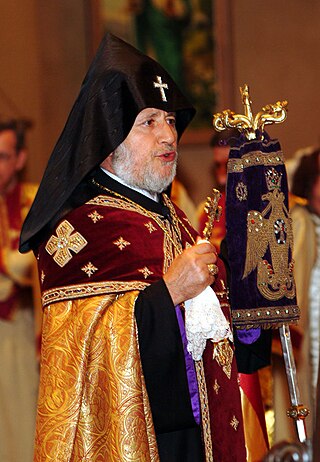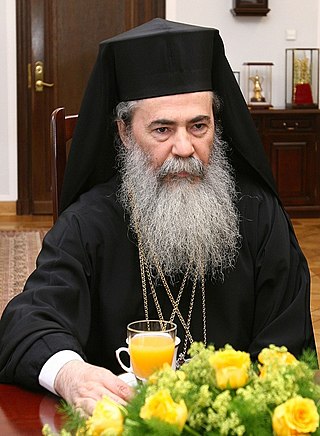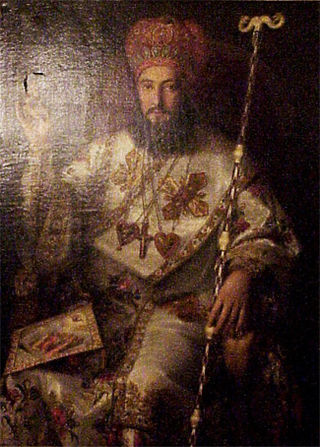Related Research Articles

Augustine of Canterbury was a Christian monk who became the first archbishop of Canterbury in the year 597. He is considered the "Apostle to the English" and a founding figure of the Church of England.
Pope Gregory II was the bishop of Rome from 19 May 715 to his death. His defiance of Emperor Leo III the Isaurian as a result of the iconoclastic controversy in the Eastern Empire prepared the way for a long series of revolts, schisms, and civil wars that eventually led to the establishment of the temporal power of the popes.

Year 594 (DXCIV) was a common year starting on Friday of the Julian calendar. The denomination 594 for this year has been used since the early medieval period, when the Anno Domini calendar era became the prevalent method in Europe for naming years.

The Catholicos of All Armenians is the chief bishop and spiritual leader of Armenia's national church, the Armenian Apostolic Church, and the worldwide Armenian diaspora. The Armenian Catholicos is also known as the Armenian Pontiff and by other titles. According to tradition, the apostles Saint Thaddeus and Saint Bartholomew brought Christianity to Armenia in the first century. Saint Gregory the Illuminator became the first Catholicos of All Armenians following the nation's adoption of Christianity as its official religion in 301 AD. The seat of the Catholicos, and the spiritual and administrative headquarters of the Armenian Church, is the Mother See of Holy Etchmiadzin, located in the city of Vagharshapat.

The Patriarch of Alexandria is the archbishop of Alexandria, Egypt. Historically, this office has included the designation "pope".

The Greek Orthodox patriarch of Jerusalem or Eastern Orthodox patriarch of Jerusalem, officially patriarch of Jerusalem, is the head bishop of the Greek Orthodox Patriarchate of Jerusalem, ranking fourth of nine patriarchs in the Eastern Orthodox Church. Since 2005, the Eastern Orthodox patriarch of Jerusalem has been Theophilos III. The patriarch is styled "Patriarch of the Holy City of Jerusalem and all Holy Land, Syria, beyond the Jordan River, Cana of Galilee, and Holy Zion." The patriarch is the head of the Brotherhood of the Holy Sepulchre, and the religious leader of about 130,000 Eastern Orthodox Christians in the Holy Land, most of them Palestinians.

The Armenian Catholic Church is an Eastern Catholic particular churches sui iuris of the Catholic Church. It accepts the leadership of the bishop of Rome, and is therefore in full communion with the universal Catholic Church, including the Latin Church and the 22 other Eastern Catholic Churches. The Armenian Catholic Church is regulated by Eastern canon law, summed up in the Code of Canons of the Eastern Churches.

The Equestrian Order of the Holy Sepulchre of Jerusalem, also called Order of the Holy Sepulchre or Knights of the Holy Sepulchre, is a Catholic order of knighthood under the protection of the Holy See. The pope is the sovereign of the order. The order creates canons as well as knights, with the primary mission to "support the Christian presence in the Holy Land". It is an internationally recognized order of chivalry.

John IV, also known as John Nesteutes, was the 33rd bishop or Patriarch of Constantinople. He was the first to assume the title Ecumenical Patriarch. He is regarded as a saint by the Eastern Orthodox Church which holds a feast on September 2.

The Melkite Greek Catholic Church, or Melkite Byzantine Catholic Church, is an Eastern Catholic church in full communion with the Holy See as part of the worldwide Catholic Church. Its chief pastor is Patriarch Youssef Absi, headquartered at the Cathedral of Our Lady of the Dormition in Damascus, Syria. The Melkites, who are Byzantine Rite Catholics, trace their history to the early Christians of Antioch, formerly part of Syria and now in Turkey, of the 1st century AD, where Christianity was introduced by Saint Peter.
Philotheos Kokkinos was the Ecumenical Patriarch of Constantinople for two periods from November 1353 to 1354 and 1364 to 1376, and a leader of the Byzantine monastic and religious revival in the 14th century. His numerous theological, liturgical, and canonical works received wide circulation not only in Byzantium but throughout the Slavic Orthodox world.

Gregory III Laham, B.S., Emeritus Patriarch of Antioch and All the East, of Alexandria and Jerusalem, is the former spiritual leader of the Melkite Greek Catholic Church. He was elected on November 29, 2000, succeeding Patriarch Maximos V Hakim. He retired on May 6, 2017.

Patriarch Gregory II Youssef, also known as Gregory II Hanna Youssef-Sayour, was Patriarch of the Melkite Greek Catholic Church from 1864 to 1897. Gregory expanded and modernized the church and its institutions and participated in the First Vatican Council, where he championed the rights of the Eastern Catholic Churches.

Maximos III Michael Mazloum, was patriarch of the Melkite Greek Catholic Church from 1833 until 1855. As patriarch he reformed church administration and bolstered clerical education. He was also the first Melkite patriarch granted civil authority by the Ottoman Empire when the Melkites were recognized as a unique millet.
Articles related to Christianity include:
Amos of Jerusalem was the patriarch of the Church of Jerusalem from 594 to 601, having succeeded as patriarch after the repose of Patr. John IV.
Robert of Nantes was the Latin patriarch of Jerusalem from 1240 to 1254.
Gerold of Lausanne, was abbot of Molesme, abbot of Cluny, bishop of Valence, and Latin patriarch of Jerusalem in the 13th century.
References
- ↑ The History of the Church of Jerusalem.
- ↑ Jerusalem Patriarchate website, Apostolic Succession section
- ↑ Amos, patriarch of Jerusalem, 601 Archived 2016-03-05 at the Wayback Machine .
- ↑ Epistle: To Amos, Patriarch of Jerusalem.
- ↑ Patrol. Graeca., LXXVII, 890.